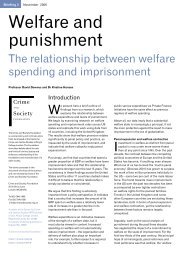PRISON SERVICE
PRISON SERVICE
PRISON SERVICE
- No tags were found...
Create successful ePaper yourself
Turn your PDF publications into a flip-book with our unique Google optimized e-Paper software.
such men will resort to previous behaviours. Thereforefor risk reduction that is generalisable acrossenvironments, personality psychopathology must betreated and not just managed. Personality disorder is aconstellation of coping strategies that a persondevelops as a response to developmental experience.There are manifest dysfunctions of thinking, feeling,behaviour and interpersonal relationships. As theoffending is linked to those areas of dysfunction, theprogramme aims to address the developmentalexperiences that generate those areas of dysfunction.Thus throughout the programme on The Fens Unit,those aspects of the personality that lead to offendingfor each individual are assessed and the remedialtherapeutic experiences directly address the aetiologicalpersonality characteristics that have resulted in theoffending behaviours.Consequently work on eachprisoner’s offending behaviours isindividually formulated toinclude a developmentalpsychopathology with detailedassessment of factors that willincrease and those that willdecrease risk. There is anindividual assessment of themotivations to offend, atcognitive and affective levels,defining, directly observing,challenging and recordingparallel offending behaviours.Those factors that increase riskfor that individual becometreatment targets and the interventions are intrinsic toevery aspect of the programme. Each of these factorshas been identified for each prisoner and these areasare worked on in both formal interventions (describedbelow) and on a daily basis by officers on the landingsand workshops who observe and address hisbehaviours. These daily observations are communicatedat debriefing so there is constant monitoring of hisbehaviours, beliefs and emotional regulation. Theoffences that the men on the unit have committed aredirectly interpersonal offences — therefore thetreatment model is cognitive interpersonal. Thistheoretical model is based on a holistic model of humanfunctioning where it is believed that the personalitycharacteristics a person develops are a result of theinteraction between genetic predisposition andexperience.The aim is to develop boundaried relationshipswith prisoners through which they can experiencereparative interventions that will affect all aspects oftheir functioning. This requires that the prisonersexperience change at the level of affect; this means atan emotional level, not merely on a cognitive andPersonality disorderis a constellation ofcoping strategiesthat a persondevelops as aresponse todevelopmentalexperience.behavioural level. The programme involves thefollowing components —Individual Therapy (IndT) — This startsimmediately the prisoner enters treatment and focuseson the development of an attachment relationship inwhich the aetiological factors of the personalitydisorder can be explored and addressed, workingtherapeutically at the level of affect. This allows theprisoner to experience empathy at the level of affectiveattunement (feeling with the person) rather than solelyat the level of verbal cognitions. During the individualtherapy every aspect of the person’s life past, presentand future are addressed. Importantly, all areas relatedto offending are thoroughly explored in depth and at anemotional, as well as cognitive level. To work at theemotional level is vital if real sustaining change is to bebrought about.Personality DisorderAwareness Group Weeklysessions for 25 weeks, facilitatedby therapists and prison officers.This is mainly a psycho-educationgroup to help prisonersunderstand their disorders.Cognitive InterpersonalGroup Therapy (CIGT) This is anunstructured psychotherapygroup which focuses on theinterpersonal relationshipsbetween all involved in thegroups including the facilitators,making explicit the connectionbetween the behaviours,cognitions and emotions within those relationships andconnection between relationships and offending. Thisgroup also aims to develop a sense of connectionbetween group members, for prisoners to be able tochallenge each other and to allow self to be challengedregarding their distorted beliefs about themselves andothers and to find ways to resolve conflict with others ina healthy manner. This group also focuses on theprisoner’s ability to take emotional responsibility for hismaladaptive behaviours in both the past and in thepresent by understanding the process of paralleloffending and make positive changes to reduce suchstrategies.Schema Focused Therapy Group (SFTG)Schemas are underlying beliefs developed throughexperience which have a powerful (mostly unconscious)influence on behaviour. Groups educate prisonersabout distorted schemas which are connected tooffending and how these schemas are maintained.Groups will shift from education and awareness-raisingto more active challenging of distorted beliefs andmethods of behaving in order to maintain these beliefs.Thus this group aims to enable the prisoner to be able48 Prison Service JournalIssue 192











